Flower bricks are wonderfully practical with an often simple design that is regaining popularity. They have also inspired gardener Hannah Gardner to explore the many different vessels we can use to display flowers, and to make the most of the everyday plants and wildflowers we sometimes take for granted. Here are a few ideas to try:
May Morning
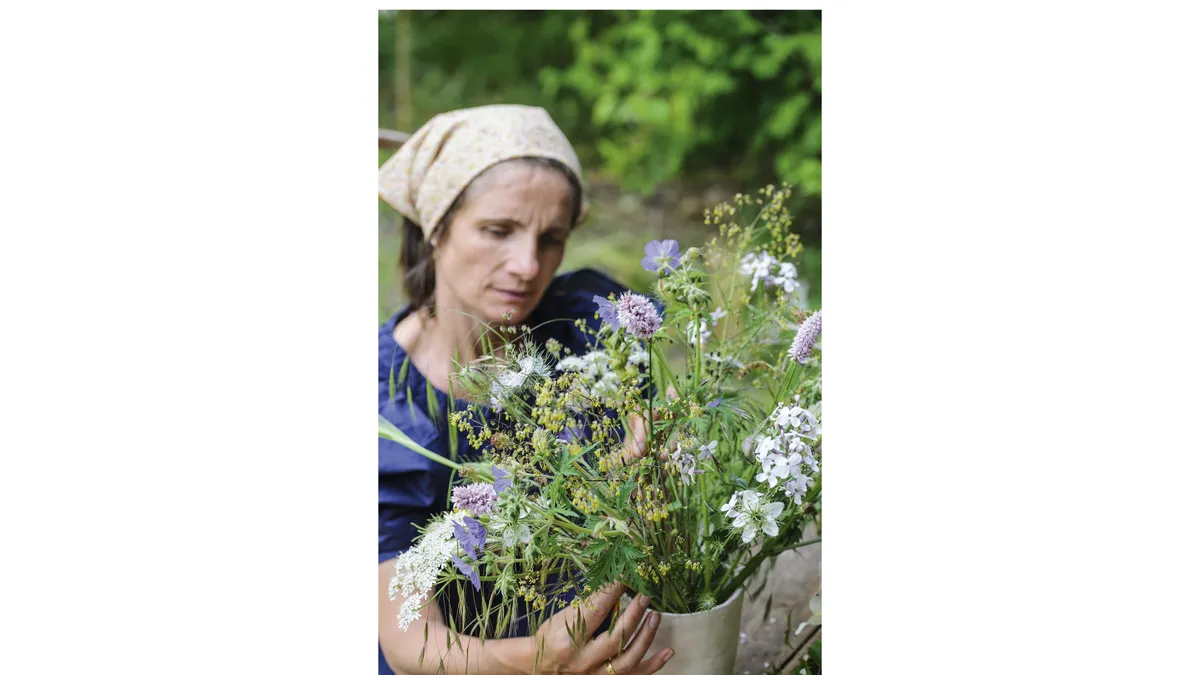
A joyful arrangement of cottage-garden plants and wildflowers that hopefully conveys the cheerfulness and energy of an early summer hay meadow.
Container and composition
This simple but interesting ceramic flower bucket with tiny elfin handles is fun as it plays with proportion, the wide neck gives lots of scope for a large bunch. For contrast I’ve grouped it with a low ornate flower brick holding a single stem of a show-stopping fancy flower. The neutral colour of the peony enables the eye to explore the sculptural detail of the little flower brick.
Floral selection and care tips
For the bucket I selected cottage garden stalwarts geraniums and the filigree annual nigella and arranged them with a few native wild plants. Uncut grasslands and roadside verges are bountiful now, as spring races towards summer. Forage only a few stems, cutting them to different lengths to achieve a naturalistic feel. I have included several grasses and various seedheads to reflect the composition of an actual meadow habitat. The heavier flowerheads of the hogweed serve as the focal flowers.
In the brick the golden stamens of Paeonia lactiflora ‘Krinkled White’ are artfully held within a large goblet of pale petals the texture of crinkled silk. The stiff foliage of the peony was actually too coarse for the narrow apertures so I replaced it with a few leaves of Plagiorhegma dubium, which has fine needle-like stalks.

Plants
1 Rhinanthus minor An annual associated with species rich meadows. 50cm.
2 Heracleum sphondylium Sturdier than cow parsley, hogweed’s lacy flowerheads are pink in bud. 1.8m. RHS H7, USDA 3a-9b†.
3 Geranium pratense A native wildflower of roadsides on chalky soils. 30-60cm.RHS H7, USDA 4a-8b.
4 Geranium x johnsonii ‘Johnson’s Blue’ Perennial with abundant flowers from late spring. 40cm. RHS H7, USDA 4a-8b.
5 Brizia media ‘Limouzi’ Shimmering semi- evergreen perennial quaking grass. 60cm. RHS H7, USDA 4a-8b.
6 Dianthus superbus Perennial with delicately fringed pastel flowers held on wiry stems. 45cm. RHS H7, USDA 3a-8b.
7 Rumex acetosa Offers branched flower spikes. 30-80cm. RHS H7, USDA 3a-7b.
8 Hordeum bulbosum Crop plant of southern Europe and the Middle East. 1.5m
9 Nigella papillosa ‘Delft Blue’ An annual with variable white-blue flowers. 60cm.
10 Sanguisorba minor Native perennial. 15-40cm. RHS H6, USDA 4a-8b.
11 Persicaria bistorta ‘Superba’ Flowers late spring and repeats through summer. 50-75cm. AGM*. RHS H7, USDA 3a-7b.
12 Hesperis matronalis Biennial with edible flowers. 90cm. RHS H6, USDA 4a-8b.
*Holds an Award of Garden Merit from the Royal Horticultural Society.†Hardiness ratings given where available
Going Dutch
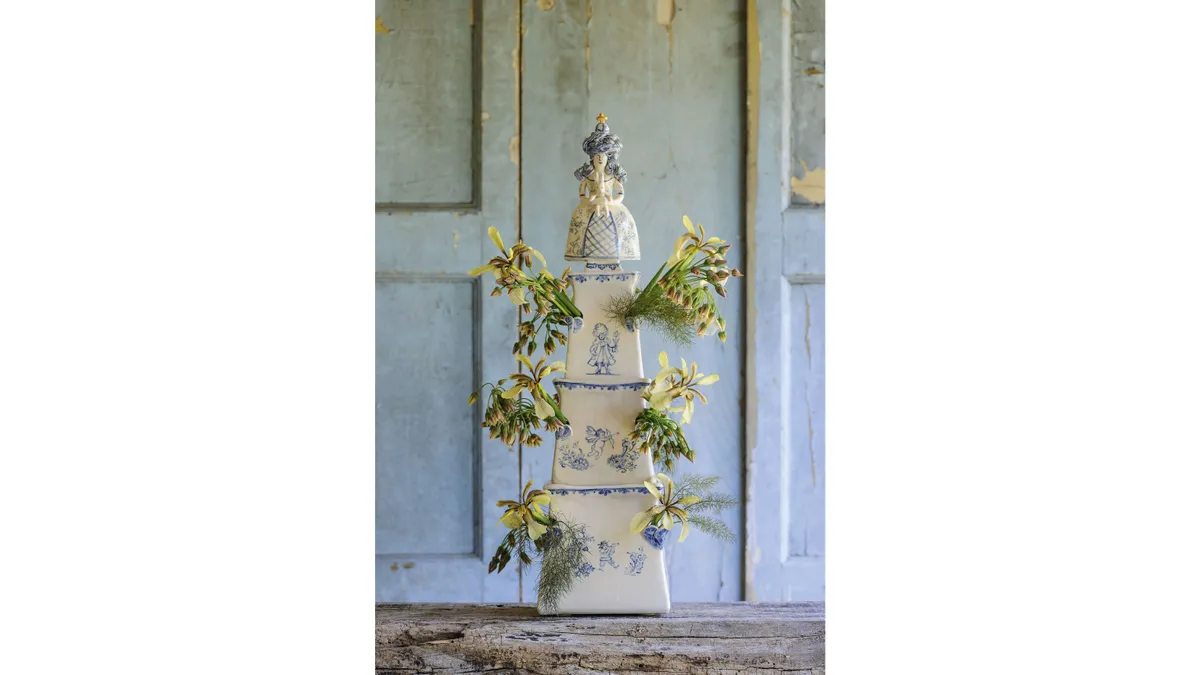
Container and composition
With such a complex stackable vase as this flowers don’t need to be attention grabbers. The figurative blue decoration on this contemporary tulipiere guided me towards a muted chalky palette. The modest but rather lovely Iris foetidissima is a native plant of woodlands and forgotten places. Much valued for the brilliance of its orange seeds in autumn and an unfussy disposition, the summer flowers are often overlooked. This distinctive pale-yellow and lilac variety is superior in a vase, the beauty of the veining fully appreciated close up. The graceful mother-of-pearl flower clusters of the allium add further detail with fennel foliage used as a textural accent, softening the angles and complementing the metallic lustre of the iris.
Floral selection and care tips
In this vase each floor is watertight so you must water each compartment storey of the vase to make these flowers last up to two weeks once cut. It is easier to use the fennel foliage attached to a flowering stem and be sure to change the water every three days to avoid bacterial build up. Ideally, pick your flowers in the cool of morning when their stems are distended and full of water.
Plants
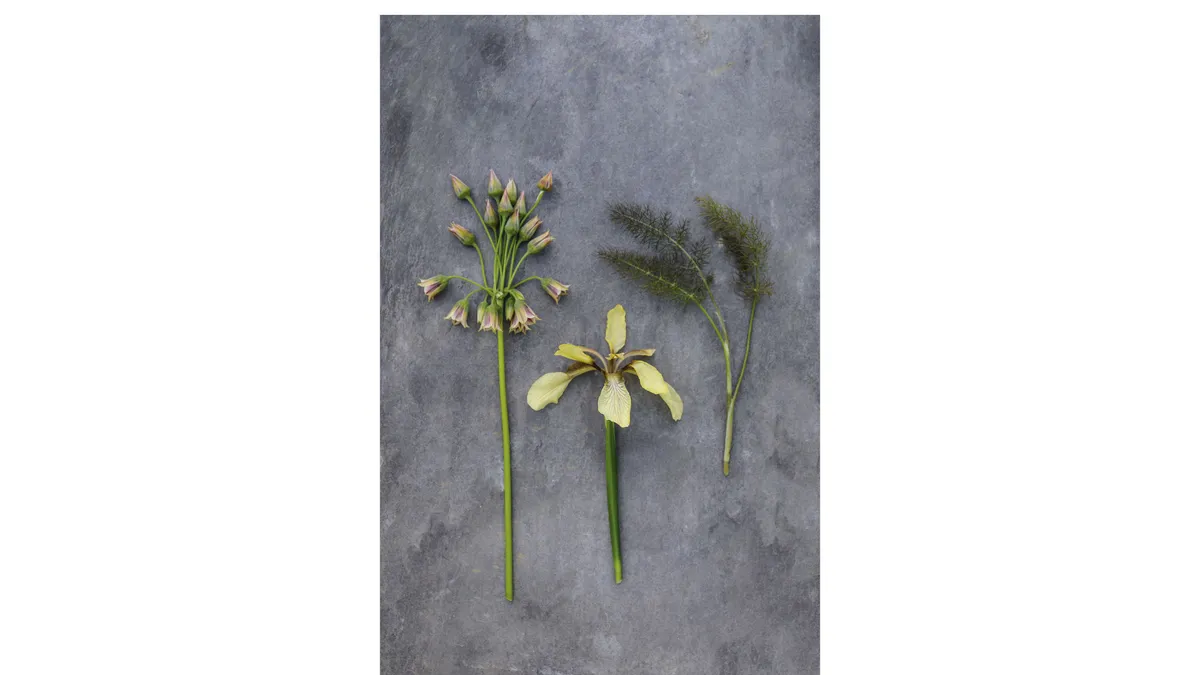
1 Allium siculum Autumn planted bulb with candelabra flowers on long sturdy stems. Flowers May to June. 1.2m. RHS H5, USDA 4a-9b.
2 Iris foetidissima var. citrina Variation of a native iris that does well in tricky, dry shade. 60cm. RHS H6, USDA 6a-9b.
3 Foeniculum vulgare ‘Purpureum’ Sun-loving perennial herb with soft feathery foliage. 1.8m. RHS H5,
USDA 4a-9b.
Spirit of Japan
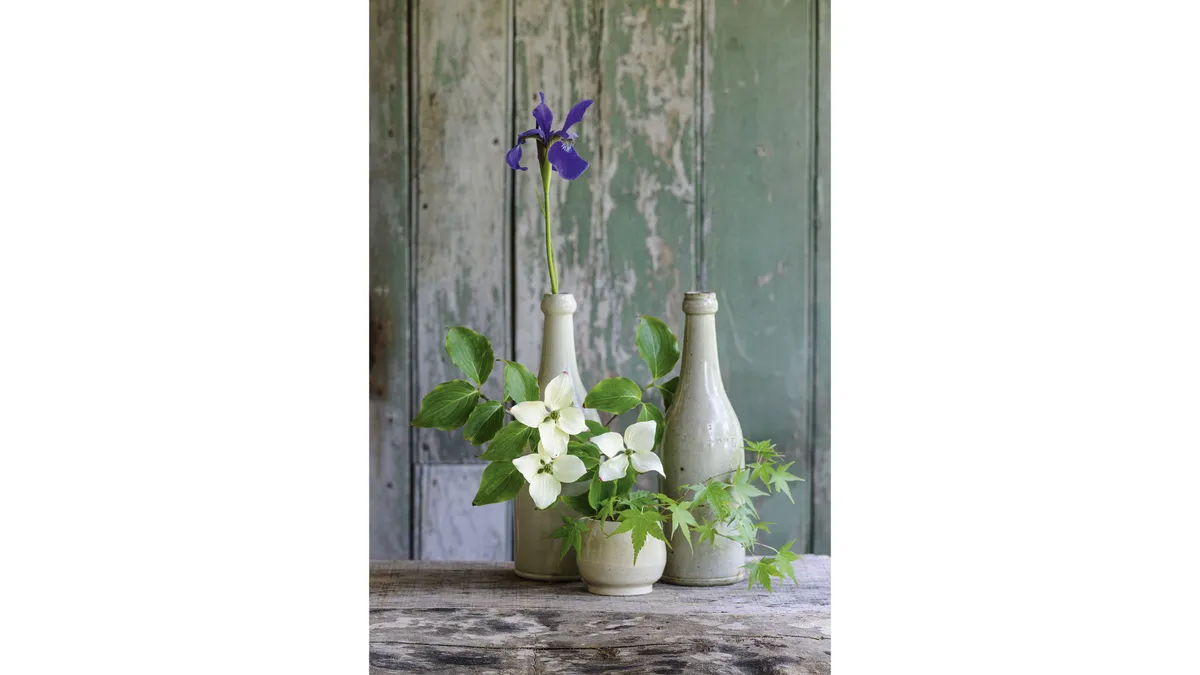
A calming seasonal display that captures a fresh, early summer moment and creates a contemplative, serene atmosphere. My mother is a potter, and I grew up surrounded by beautiful functional ceramics many of which are still in use at home with (and without) flowers in them. She made this rustic tea bowl, which was influenced by the folk art ceramics of Japan, and I use it to hold plants that are strongly associated with, or grow wild in Japan.
Container and composition
The simple composition and clean lines of the light-toned pottery allow the newly unfurled acer foliage and dramatic sculptural flowers of the Chinese dogwood to take centre stage.
Vintage beer bottles (from Burgundy circa 1900) provide a strong vertical accent. I placed them behind to create an uncluttered smooth canvas for the cornus flowers and to support the shapely stem of the iris. The footed tea-bowl is a much-loved vessel, lightly textured, gently rounded and stable. The slender neck of the bottles directs the gaze up towards the iridescent iris bloom. The shot of colour has greater impact as it stands apart from the neutralising green foliage.
Floral selection and care tips
Acers, with their rich autumn colour, are synonymous with Japan, and their fine skeletal branches have a bare architectural appeal during winter. Irises are popular in Japanese iconography, symbolising purity. Wide and shallow containers usually require something to give additional support. Heavier stems can be pushed into a spiked metal flower frog secured to the vessel with tape. Known in Japan as kenzan, these devices are used in the Japanese flower-arranging art of ikebana. Other stems may benefit from being threaded through a loose nest of chicken wire or pliable twigs. Both options are sustainable and create a more solid base.
Plants
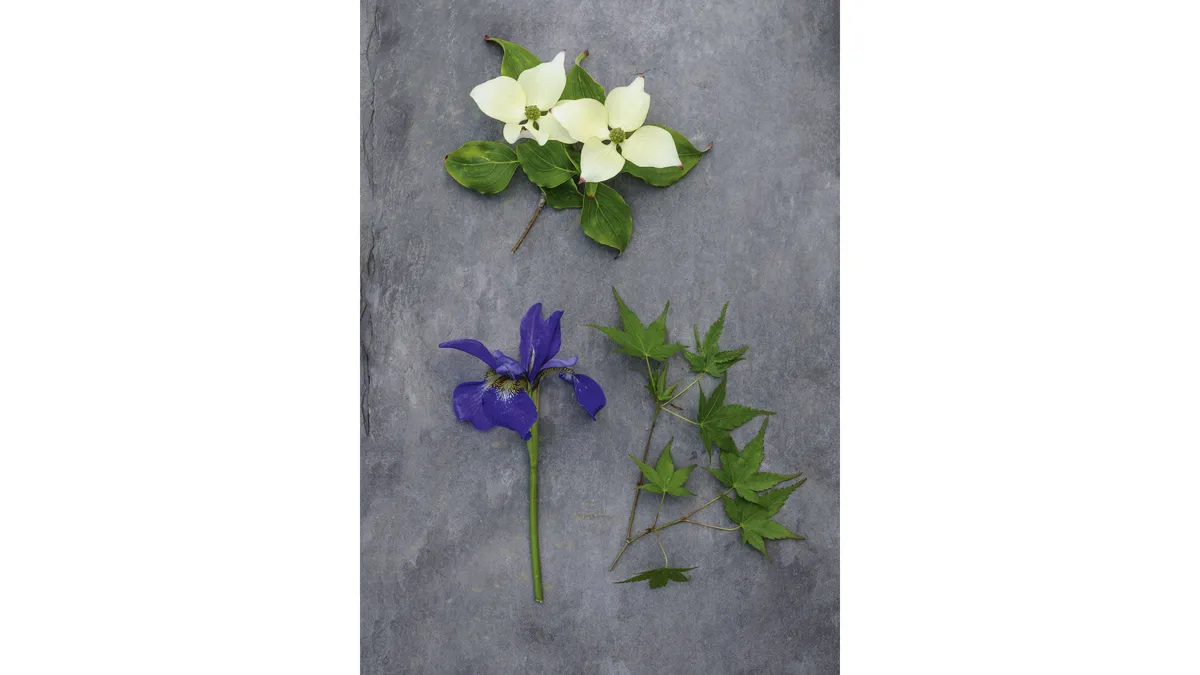
1 Cornus kousa var. chinensis Chinese dogwood is a large, deciduous shrub or small tree that flowers in May and June. Its waxy white bracts form a stiff collar for insignificant looking flowerheads that develop into delicious scarlet fruits by autumn. 4-8m. RHS H6, USDA 5a-8b.
2 Iris ‘Blue Moon’ The heavily veined bright violet-blue blooms of this Siberian iris are held on elegant stalks late spring-early summer. 80-90cm. RHS H7, USDA 3a-8b.
3 Acer palmatum This Japanese maple is a small, characterful tree, selected for its leaf shape and vibrant autumn colour. Their restrained elegance – each branch is a study in nuance and poise – make this a valuable foliage plant throughout the summer. 6-10m. RHS H6, USDA 5a-8b.
Where to buy
For vessel: Cécile Daladier ceciledaladier.com
Charlotte McLeish Ceramics, charlottemcleishceramics.bigcartel.com
Jenny Gardner Pottery Via Instagram @jennygardnerpottery
The Shop Floor Project 01229 584537, theshopfloorproject.com
Sophie Conran 03332 401 228, sophieconran.com
For flower frogs and other accessories
Niwaki 01747 445059, niwaki.com
Sarah Raven 0345 092 0283, sarahraven.com Wood & Meadow woodandmeadow.com
Or read our guide: